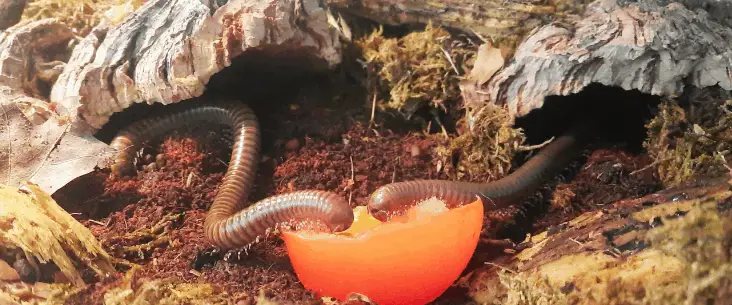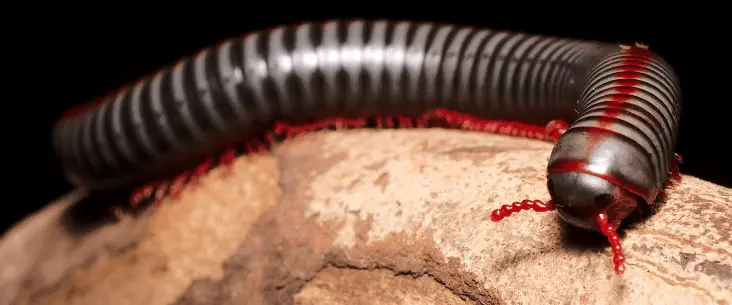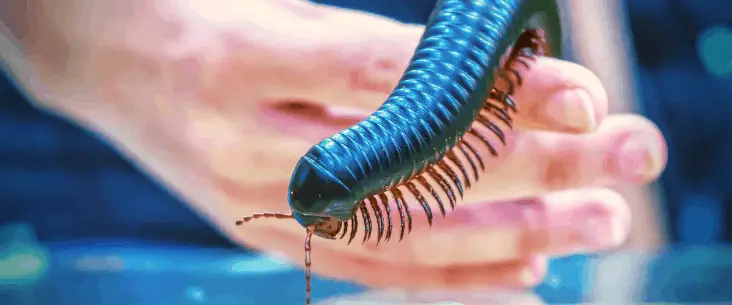Millipedes are fascinating anthropods, and it is mesmerizing to observe how those many little feet wave and make the tubular body move forwards. Many millipede species are hardy, are easy to keep and take care of, although, you need to make proper preparations to fully enjoy the life of millipedes. But first, let’s find out more about millipedes!
About millipedes
Millipedes belong together with centipedes and other multi-legged bug creatures to the group of myriapods — where the name ‘myriad’ actually means 10.000, the multi-legged creature that has the most legs (Illacme plenipes) has “only” 750 legs. There are about 12.000 species of millipedes described, making it the largest class within the multi-legged animals.
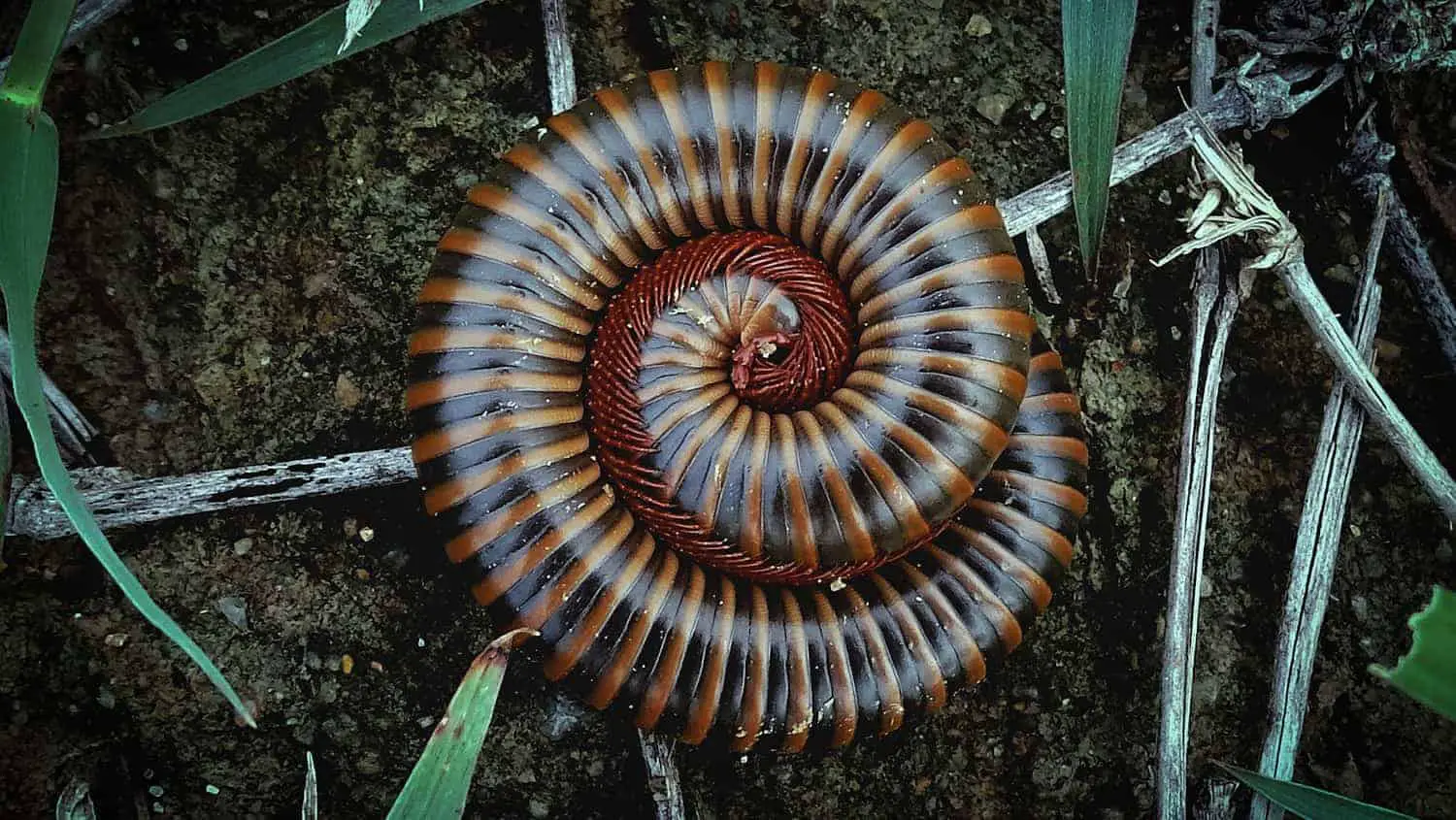
Morphology and anatomy
Millipedes belong to the phylum anthropods and have an exoskeleton made out of many segments. Millipedes are characterised by having two pair of feet on most body segments, which are actually two single segments that are fused together.
The first ‘segment’ don’t have legs, and it contains the antennae, mouthparts and eyes (ocular field). Where sight is presumably only limited to see the difference between light and dark, and some ultraviolet light, their sense of touch is more developed. Although they can hear they feel vibrations through their body and legs. The antennae are used to smell and taste. The last segment also hasn’t a pair of feet, and this is where the anal valves are located, sometimes also called the anal segment. On the second segment is the sexual apparatus located.
The respiratory system contains two pairs of spiracles on each fused segment — the ones with two legs — and is used to breathe. Along the trunk, the section after the head is the digestive system. They use bacteria to help break down the detritus that is eaten. Their mouthparts
Millipedes vs centipedes
Although millipedes and centipedes belong to the same group of multi-legged species, there are some distinctive features which make them different. Millipedes have two pair of legs per segment — or two segments fused together, are docile and are detritivores, eating on decaying wood, leaves and plant matters. Centipedes, on the contrary, have one pair of feet on each segment, are predominantly carnivores and eat mostly insects, and are venomous and can inflict painful bites. Millipedes are also generally slow-moving, where centipedes can be rather quick.
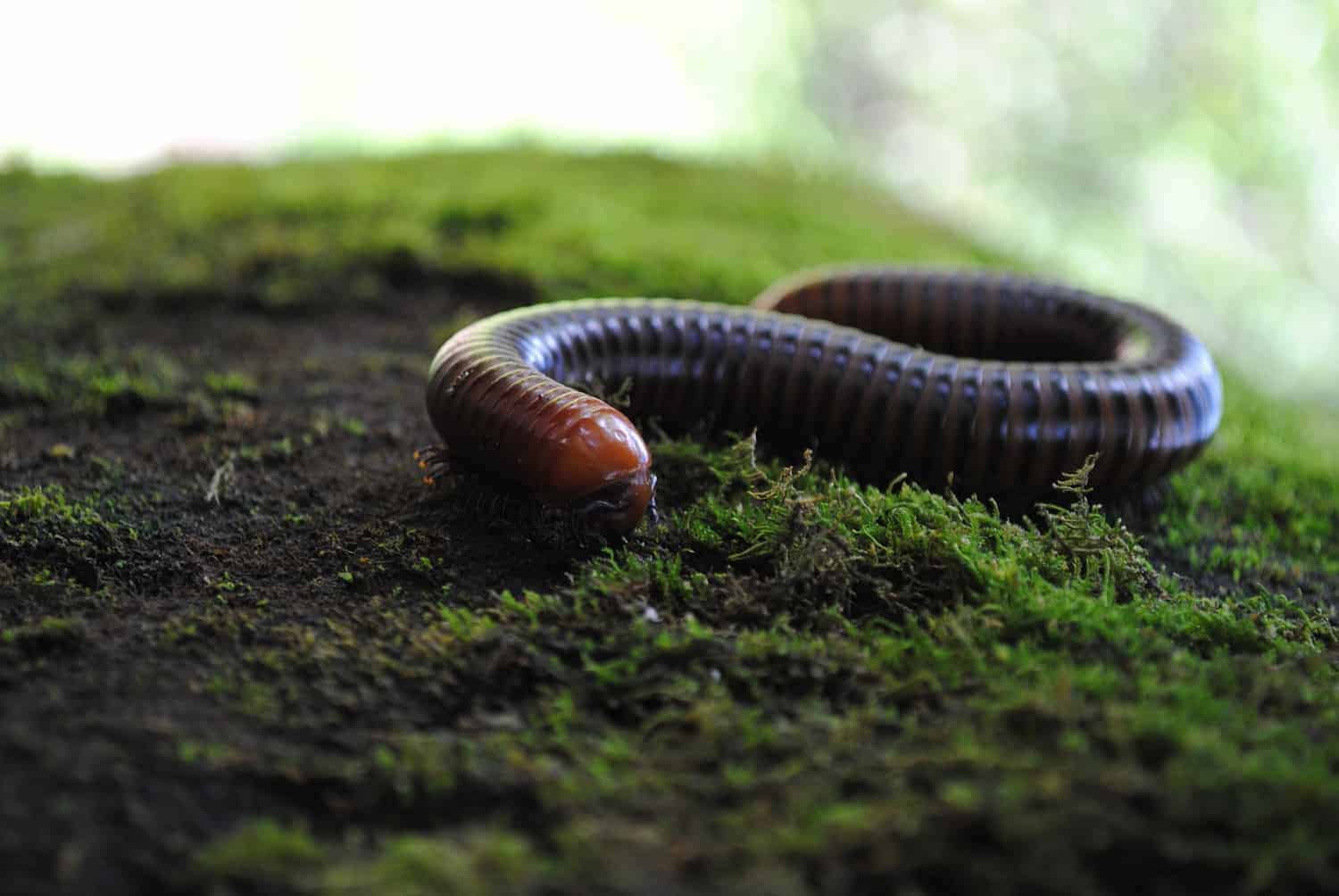
Where do millipedes live?
A better question would be, where do they not live? Millipedes occur on every continent (except Antarctica). The most of giant millipedes (up to 35cm/14″) can be found in the tropics, but many millipedes live in temperate habitats as well. Generally, these latter millipedes are much smaller, up to 2cm (0.8″). They typically live in leaf litter, dead wood, or up or just below the soil. However, there are some exceptions, where millipedes live in deserts, caves, and even the alpines. Most millipedes prefer a more humid environment.
Are millipedes dangerous?
No, due to their lack of speed and the inability to bite/sting, they are not dangerous or harmful to humans. Millipedes primary defence is to curl into a coil protecting their delicate lower body with their hard outer exoskeleton.
However, many species also emit a smelling liquid secretion when feeling endangered. Among the secretion, hydrogen cyanide can be found and can irritate and may burn the skin a bit. Some people are more sensitive to this secretion than others.
Common millipede species as pets
Many millipede species are kept as a pet. But the species that are kept are often the more giant and tropical ones. Although this care guide focuses more on keeping the African giant black millipede (Archipirostreptus gigas) — the most common millipede — many information and practical tips are useful for any tropical giant millipede species kept in captivity. Not all millipede species are evenly successful in being held at home, and some needs just a bit more experience. Some popular millipede species that are kept are:
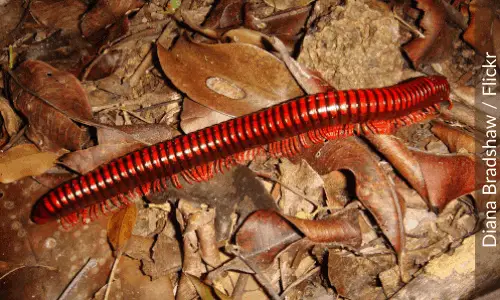
Madagascan fire millipede
(Aphistogoniulus sp.)
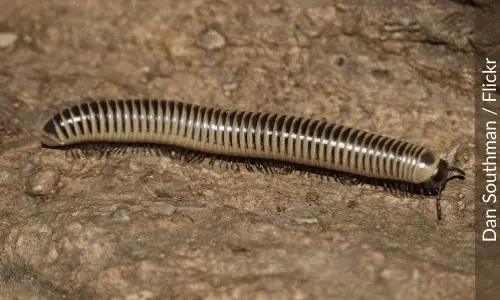
Ivory millipede
(Chicobolus spinigerus)
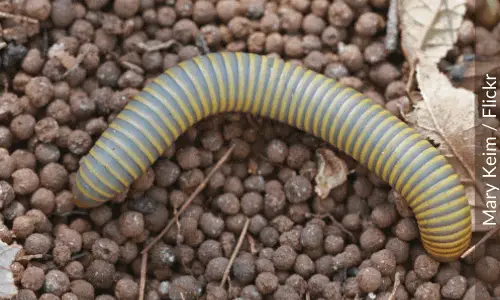
Florida giant millipede / Smokey oak millipede
(Narceus gordanus)

Chocolate millipede
(Ophistreptus quineensis)
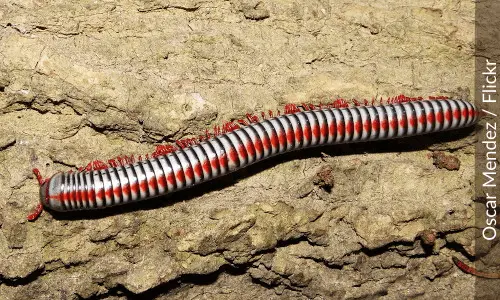
Rainbow millipede
(Apeuthes spp.)
Note: there are some reports that Vietnamese rainbow millipede (tonkinbolus dollfusi) can be quite hard to keep and breed.

Bumblebee millipede
(Anadenobolus monilicornis or Anadenobolus modestior)
Note: can be a bit more difficult to keep and breed

Texas giant gold millipede / Pumpkin millipede / Desert millipede
(Orthoporus ornatus)
Note: can be a bit more difficult to keep and breed
Although many people, but also pet shops, use their common names, and unfortunately often different names are used for the same species. This poor naming convention makes it sometimes difficult to clarify which species is meant with a particular name. Therefore it is good practice always to use (additionally) the Latin name instead — or sometimes called the scientific name.
CAUTION: Pill millipedes (Glomeridans spp. and Sphaerotheriidans spp.) do not make good pets. There is not enough knowledge about these species (yet) and many die prematurely in captivity (already within weeks to a couple of months). You can look at keeping isopods (pill bugs and sow bugs) instead. Although much smaller, they have similar shapes and many isopods have bright and beautiful colours.
How to keep millipedes as a pet?
From this point on, we focus on how to keep and how to care for your millipedes. This general care guide can be used for most tropical and common giant millipedes in captivity. Although many information is useful for the many species, it is always useful to do your own research on its specific wild habitat and their requirements. First, we will discuss how to set up the enclosure and create a proper environment — the so-called captive habitat — as a foundation and decent start for keeping millipedes.
Habitat setup
The first step is to set up a habitat to keep your millipede safely and healthy for its entire life, and if you have males and females also breed successfully. The habitat needs to be an enclosed space that prevents escapes and will keep the environment stable. Important features are the ventilation capacity of the enclosure, the closing of doors and openings and, of course, the visibility to enjoy your millipede pet.
Don’t forget that the location of the enclosure is equally important. Not only to create a proper environment, but also the safety of your millipedes. Make sure that the enclosure is placed stable and can’t be knocked over quickly. Also make sure that free walking pets can’t break into the enclosure, damage it or knock over. Also, never place an enclosure into direct sunlight. Not only do you risk of overheating the enclosure and therefore the animals, but it also causes the substrate to dry out very quickly (more on that later on).
Enclosure type
There are different types of enclosures you can use to keep millipedes. We will discuss the most common used enclosures that are proven to work well.
- Terrarium — often intended for reptiles, but are perfect for millipedes.
- Aquarium — can easily be converted as a proper millipede enclosure.
- Plastic container — These enclosure types are cheap and easy to adapt, especially when you intend to breed with them.
- DIY build enclosure — if you are handy, you can build your own enclosure.
Enclosure ventilation
Ventilation is, together with the humidity, one of the most important variables of your enclosure. The ventilation capacity should be enough to make an adequate airflow. Although ventilation affects the humidity, without ventilation, it will be a harmful environment for your millipedes.
Terrariums have (almost) always the proper amount of ventilation capacity available. However, aquariums with a lid need to be adapted to create enough ventilation. It is the same when you use a plastic container. Both need ventilation by drilling small holes in the lid.
Depending on the size of your enclosure you need to drill holes along the edges every 5cm (2″). So for example, a lid of 30cm x 30cm (12″ x 12″) have around a total of 20 holes along the edges to create adequate ventilation. You can regulate the ventilation by covering or opening some of the ventilation holes.
Enclosure size
As a general guide to decide how large your enclosure needs to be, you can say that the enclosure should be three times the length of the theoretical adult size millipede in width, except for the height. The height should be at least two times the length.
So, let’s say your millipede has a theoretical adult size of 25cm, then an enclosure of 75cm x 30cm x 50cm should be large enough. It would be even better if you have an enclosure that has a surface of three times the length in any direction, so in this case a surface of 75cm x 75cm. Surface size is also important to be able to provide enough substrate, which is part of its primary food source and the key to keep the humidity level stable and your millipede healthy.
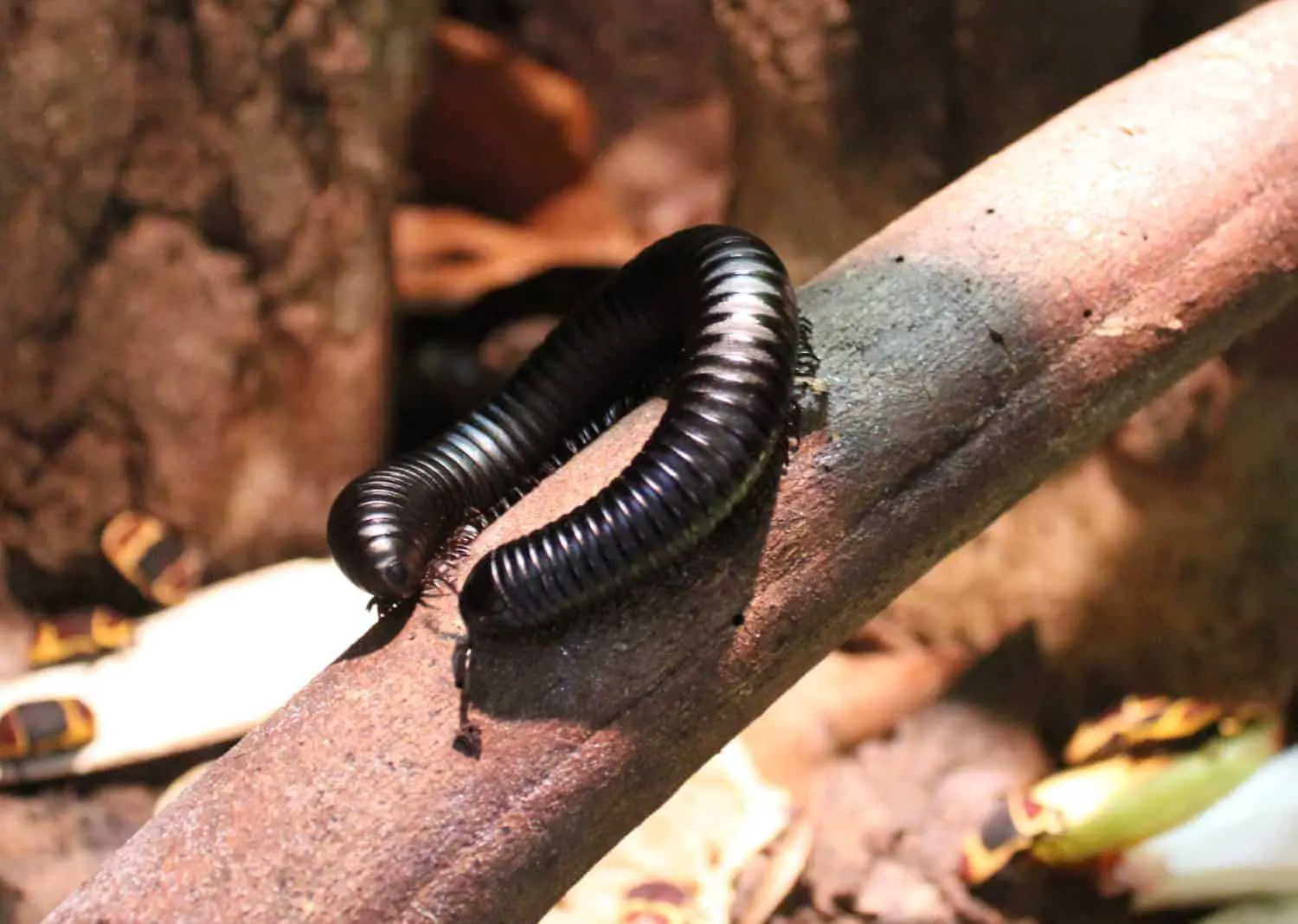
Substrate and furnishing
The substrate is the most crucial feature of the habitat to keep your millipede alive, healthy and have a long life. You can say that, for a millipede, the substrate is equal to life. They use the substrate to dig, hide, drink, eat, produce offspring, and live in. Proper preparation and care need to be taken to set up your substrate right from the beginning. The substrate should contain a base component and a food component and needs to have at least a depth of around 7cm to 10cm (3″-4″). When you want to have better breeding results, you’ll probably need a thicker layer of the substrate up to 15cm (6″).
- Substrate base component — The base substrate creates substrate volume and doesn’t need a high nutritional value. The main feature of this component is to provide space to dig in, lay eggs and keep your humidity stable. There are three types of base substrate commonly used: Coconut fibre, compost and potting soil. Coconut fibre is most consistent as the base component. Potting soil and compost can highly vary in composition and may or may not include ingredients that are not healthy to millipedes. Products you should avoid to use as a substrate (or use as a small fraction of the substrate) are vermiculite, perlite and sand. Wood chips and gravel should be avoided at all times. When buying potting soil or compost, make sure it’s without added fertilizer and chemicals which may be harmful to your millipede. My recommendation is to use coconut fibre as a base substrate.
- Substrate food component — The food component is what it says, a primary food source for your millipedes. Products that can be used for this type of substrate are rotten wood, rotten leaves, sawdust, or a combination of it. Rotten wood should be of hardwood tree species. Because millipedes only nibble onto food sources and can’t bite chunks off, the rotten wood needs to be very soft (you’ll need to be able to scrape it off the wood with your fingernail). Very light, almost white pieces with insects already on it can be used, brown and black decayed wood and when wild insects avoid it should you avoid as well. Leaves are work very well and are recommended to have always into the enclosure. Also, the sawdust of untreated wood can easily be mixed into the base substrate. To use materials collected from outdoors should be at least freezer for a couple of days, but it would even be better to cook it at low temperatures (65°C-90°C or 150°F-200°F) because freezing doesn’t kill everything. In this case, leaves and sawdust are often easier to use, but all can be evenly useful.
For furnishing and decorating the enclosure, you can use all kinds of materials that you like: rocks, pebbles, bark, cork bark, wood, live plants. In the case of live plants, make sure they are not treated with pesticides or chemicals. When collecting materials outdoors, make sure you at least freeze it, but better cook it before placing it in the enclosure. Don’t use materials that are too heavy or place them in such a way that when a species is digging beneath it — what they like to do — it doesn’t crush your precious millipede.
Habitat environment
Now we illustrated the fundament of the enclosure, it is time to discuss how to make a proper environment into this habitat. Two main variables need to be set: humidity (most crucial) and temperature. Both of them are essential for the survival of your millipedes.
Humidity and moistening
The substrate needs to be kept moist at all times. Humidity is an essential aspect of keeping healthy millipedes. After moistening, you can let the substrate top layer dry a bit before it needs to be moistened again. Depending on the ventilation and airflow, and the ambient humidity of the room, you’ll need to mist the substrate from daily to once a week. Millipedes drink from the moist substrate and water drops on leaves. Never let the substrate completely dry out.
Although ventilation affects the time the damp substrate will dry out, you’ll need enough ventilation to prevent the accumulation of too much moisture and that the substrate becomes too wet. However, if you notice the substrate dries out too quickly, you can cover some of the ventilation to keep the humidity in the enclosure for longer. It would be best if you played with the humidity, because every situation is different and no one rule fits all. Keeping humidity and substrate in good condition needs practice and experience.
Temperature and heating
Many species can be kept near room temperature between 18°C and 28°C (65°F and 83°F). I have good experience to keep millipedes best at a temperature around 25°C (77°F). Always try to avoid keeping millipedes above 30°C (86°F) for longer periods, even for tropical species may result in death millipedes. Many tropical species live on the ground between the plant litter, and in this layer, it is cooler than higher above the ground. Also, in the tropics, the sun rarely penetrates to the bottom.
It can be that you need to heat the enclosure. You could use a low wattage light bulb or heat pad, as long as you make the heat source outside the enclosure. Be careful that if you heat the complete enclosure, it can cause overheating, dipping of humidity and lower moisture levels of the substrate. You can also heat half of the enclosure, so placing the enclosure half on the heat pad.
You can find out more about temperature and heating, and humidity and drinking water in our basics guide.
Cleaning the enclosure
One of the largest benefits of keeping millipedes is that you almost have nothing to clean for. The only thing that needs to be done regularly is to remove uneaten food items that are in the enclosure too long.
Additionally, you can wipe the windows once in a while with a dry or wet cloth and refresh small parts of the substrate or add some new rotten wood or rotten leaves. That’s it.
You must even be sure not to clean too much. If you refresh the substrate and leaves too often will disturb and harm your millipedes. This will be especially harmful in the case when a millipede has just moulted or with young millipedes in the substrate.
HELP! I have mites in my enclosure: Do not worry and don’t be alarmed when you notice mites within your enclosure or on your millipedes. It is completely normal to have mites. Millipedes and mites have a symbiotic relationship, where both species benefit from each other. On one hand the mites can feed dirt, parasites and stuf from your millipedes, and on the other hands your millipedes stays clean.
Clean-up crews
Clean-up crews do not have many added value to the enclosure. In fact, it can even become competition for the millipedes. Clean-up crews — which mostly exist out of isopods and small millipedes — feed on the same food source in the substrate as your millipedes do. However, isopods breed much faster than millipedes, and the enclosure can be soon overcrowded by them, drifting the millipedes away. Also, isopods are known to eat from millipede eggs and small individuals (specifically when they just moulted) which harm your millipede population.
Springtails can become beneficial and are harmless to millipedes. They eat even sources that are not eaten by millipedes. Although, you could question what the overall benefit is to add a clean-up crew.
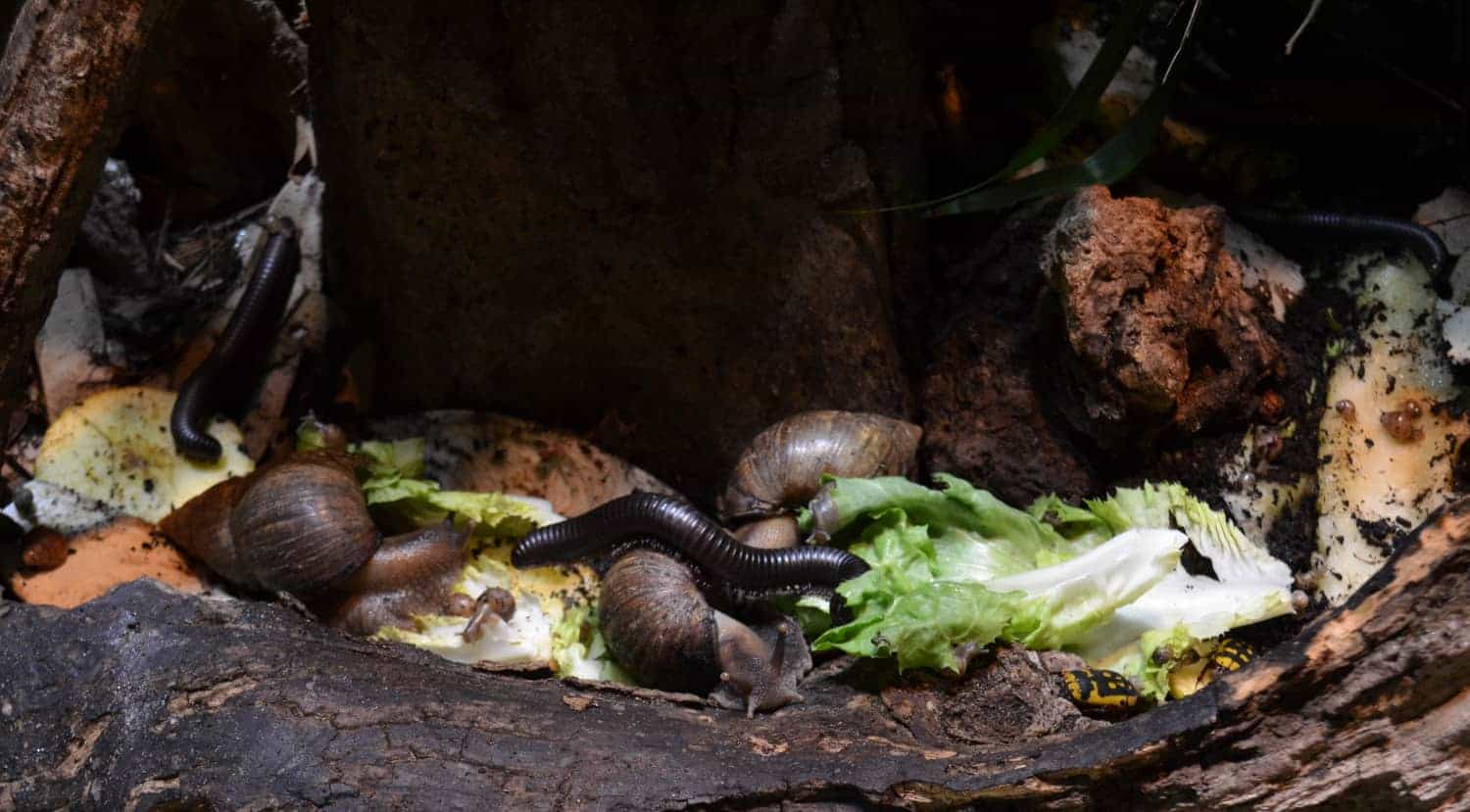
Mixed-species and communal setups
Different species of millipedes can be housed together successfully and without any major issues. The only downside is that with eggs and small millipedes, it is challenging to distinguish the different species. But you can ask yourself if that is a problem in the long run.
You can also house millipedes together with other animal species. Millipedes are kept successful with different species of beetles, like for example the sun beetle (Pachnoda marginata) or flamboyant flower beetle (Eudicella gralli). Keep in mind that there is always the possibility that beetle larvae will eat some of your millipede eggs and small millipedes. If your primary focus is to breed with your millipedes, it would be better not to keep them with other species.
Snails are also known to be successfully kept with millipedes, like the African giant snail (Achatina spp.). I have bred over 100 African giant black millipedes successfully in an enclosure with sun beetles and giant land snails.
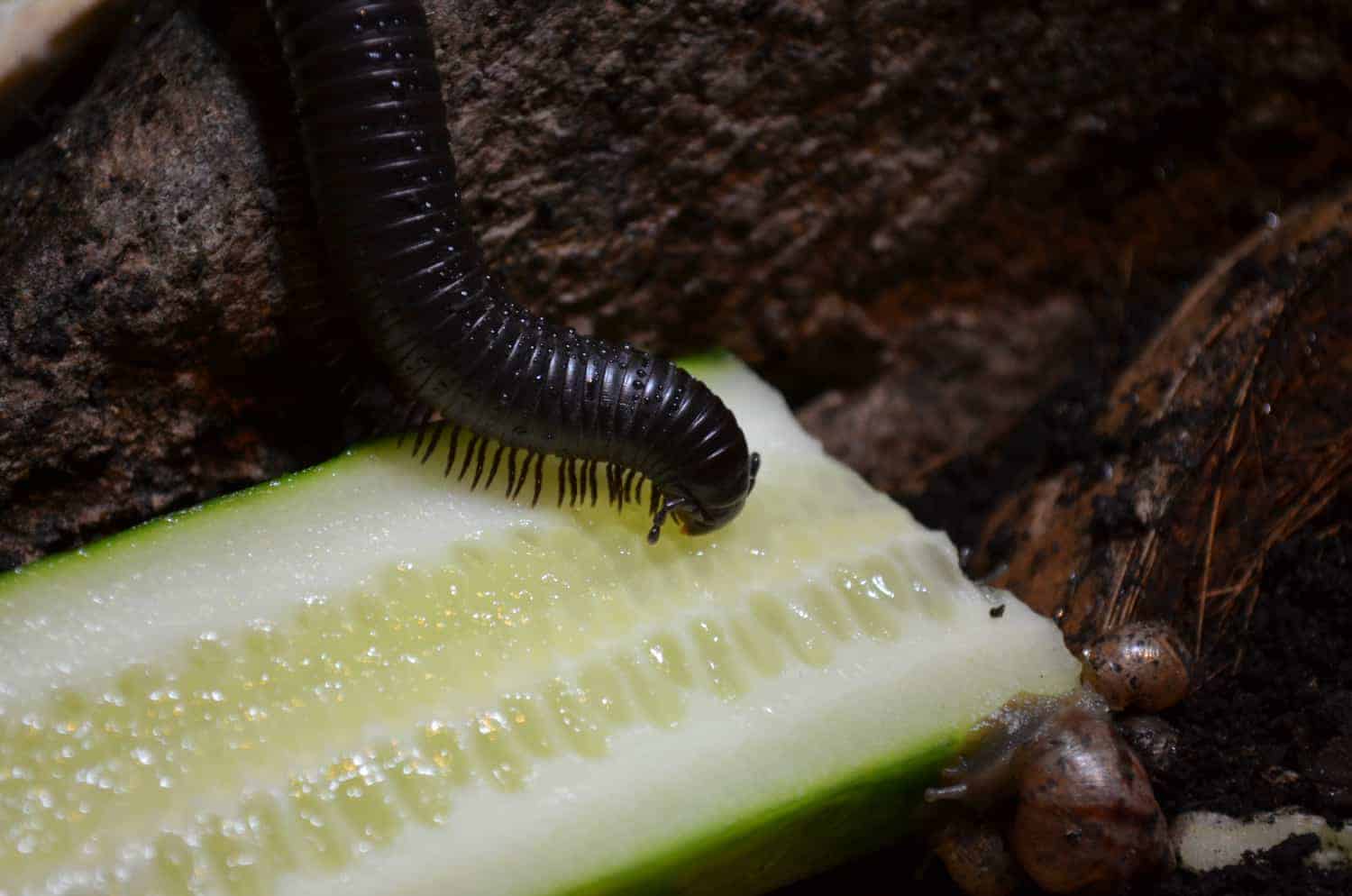
What to feed millipedes?
We already discussed that the substrate is the primary food for millipedes. A millipede can survive and be kept healthy when fed alone on this substrate, but only if the substrate is of excellent quality.
However, millipedes grow faster and will be better reproduce when providing supplemental foods. And to be honest, it is also fun to see how they nibble the food. Food sources that are suitable to feed to millipedes are fruit, vegetables, and dry dog and cat food. Not all products are accepted evenly well, and you’ll need to experiment which products are eaten best by your millipedes. Most species like to favour pumpkin, watermelon and cantaloupe; however, these products are not always available all year round.
You can just place the food item on the substrate. With the dog and cat food, I like to use a food bowl and put the dry food in. When you are spraying water, water is accumulated in the food bowl and is absorbed by the pellets, which in my experience is liked by millipedes. Also, this method makes it easier to clean.
You can feed powdered food now and then (once every one or two months). Just sprinkle some powder on the substrate and mist water on it, so it becomes wet. Products that are used are powdered milk, baby powder formula and powdered calcium supplement.
Can you handle millipedes?
Short answer: Yes, you can. The long answer: Yes, you can but rather not. Let me explain. One main characteristic that makes millipedes such a widespread species as pets is that they are suited for handling — which means they tolerate it and do not harm you or inflict any injuries. But, with that said, be aware that when dropping or falling of a millipede can cause damage to its body and eventually kill the animal. Always handle millipedes right above something soft, so above the substrate or pillow.
Besides, millipedes can be quite fragile. Especially when they just moulted, their exoskeleton is not completely hard yet. Any crack or damage to the exoskeleton may cause damage to the internal organs, which eventually result in death too.
Another aspect that must be considered is that millipedes can excrete a liquid secretion that contains among other hydrogen cyanide. It is not toxic or harmful but can be irritating and cause a rash or burning skin. Especially if you have some of that secretion on your hand and you touch your eyes or mouth, for example. And some people reacting more to these chemicals, like an allergic reaction. Always wash your hands after handling millipedes, or use unpowdered latex gloves when you want to pick up a millipede.
With care, millipedes are suitable to handle and very docile indeed. Though, I am personally not a proponent of continually handling exotic animals. There are no visual cues or scientific evidence that handling and sorts of petting/cuddling them increase their welfare or benefits them in any way.
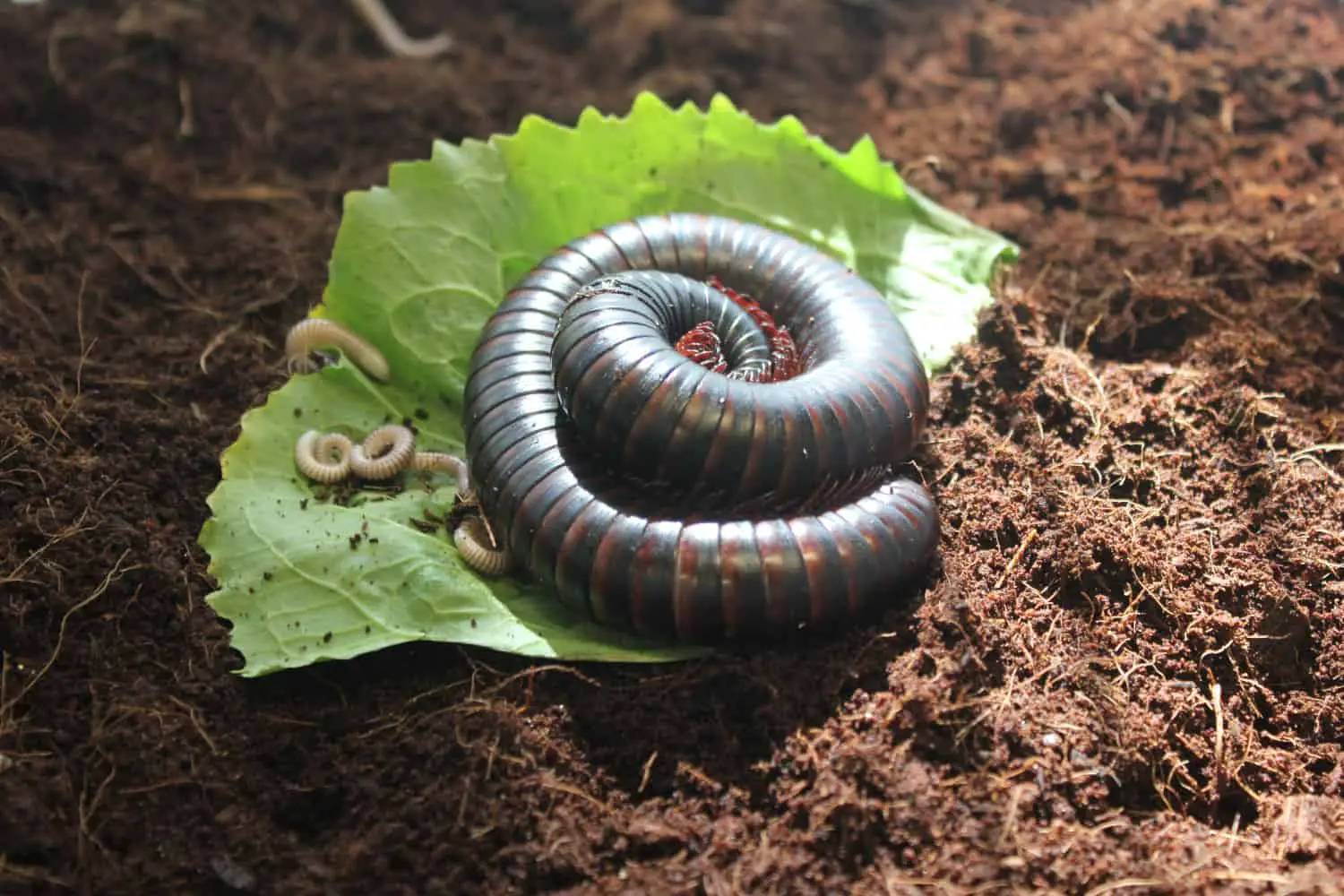
How to breed millipedes?
Nearly every species in the orders spirobolid and spirostreptid with a captive history have been bred in captivity. Many species are rather easy breeders, although some species can be more challenging to get breeding. First, let us have a look at the millipede life cycle.
Millipede life cycle
A typical lifespan of millipedes is around 1 up to 10 years, depending on the species. Most giant millipedes kept in captivity have a lifespan of at least 3 years.
When a female is mature and has mated with a male, it can lay ten to hundreds of eggs at a time. Females of most millipede species deposit the eggs in very damp soil and organic detritus. After a few weeks, the eggs will hatch and tiny young millipedes emerge.
Young millipedes stay below ground in the deep soil, eating decayed substrate that is near them. They start with only three segments with leg pairs and up to four legless segments. With every moult, there are some segment and legs added while they grow. Frequently they will eat their old skin after moulting, which contain valuable nutrition.
Maturity and adulthood are reached after the final moult. How many moults are needed to become an adult depends highly on the species. A female is now able to mate and produce eggs again. There are some millipedes known to be parthenogenetic — lay fertile eggs without mating.

Stimulate breeding
When you have followed the above practical guidance and tips, have both genders of the same species which have reached maturity, and you care for them properly; breeding will be relatively easy, and you’ll likely find young millipedes after a while. However, when after a year or so or when you observed mating adults but eggs or young millipedes do not come, you’ll need the following aspects to be checked and improve to stimulate breeding:
- The substrate needs to have a depth of at least 8cm up top 15cm (3″-6″). Lower thickness can prevent laying eggs.
- The substrate needs to be very damp (but not sopping wet). When the substrate is (too) dry, females won’t lay eggs, and laid eggs will die off.
- The substrate should be of fine material like coconut fibre and compost.
- The substrate should contain enough (read: ½ of the total) of rotten leaves and rotten wood mixed into the base substrate. Rotten wood needs to be of good quality.
- You can add an additional layer of rotten leaves on top of the substrate.
Keeping millipedes as pet FAQ
In this practical guide, I discussed many topics and shared a lot of practical tips. You should now be ready to keep and care millipedes alive, healthy and happy. If you have any questions, you can check the section below, ask them in the comment section or you can contact me with the form on the contact page.
Other bugs similar to millipedes you can keep as pets
If you like millipedes, you’ll probably also be interested in keeping the bugs below. You can also check out our page ‘Choose your bug species‘ to find many more different bugs you can keep as a pet.
Share this page!

